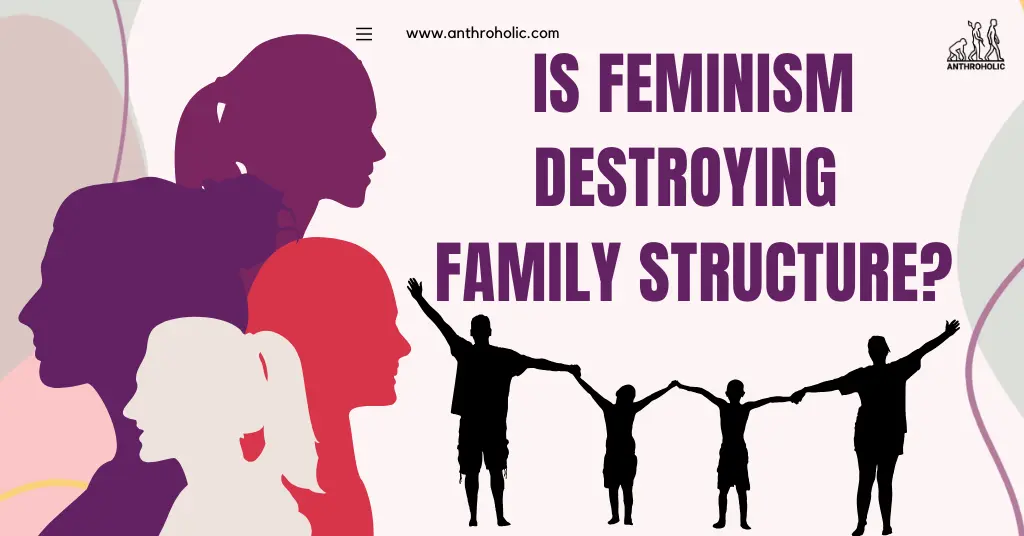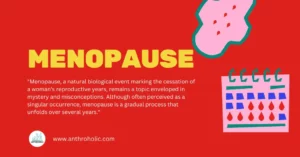+91-7303290503, +91-9557169661 | MON to SUN 10:00 AM - 6:00 PM
Is Feminism destroying Family Structure?
It’s a question that sparks heated debate: Has feminism destroyed the traditional family? We hear a lot about declining marriage rates, rising divorces, and changing household structures, and for some, feminism is the primary culprit. But is this narrative accurate?
To get to the truth, we need to look beyond the headlines. The story of the modern family isn’t one of simple destruction, but of a complex and profound transformation. Feminism is a major character in this story, but it’s far from the only one. Let’s unpack the history, the data, and the other major forces that have reshaped family life as we know it.

What Was the “Traditional” Family, Anyway?
When people talk about the “traditional family,” they’re usually picturing the 1950s model: a breadwinner dad, a stay-at-home mom, and their biological children, all living in a suburban home. This image is powerful, but it’s important to remember that it was a historical anomaly, not a timeless norm.
For centuries before the Industrial Revolution, the dominant family structure was the extended, multigenerational household. These families were economic units, working together on farms and in trades to survive. The idea of a private, nuclear family-just parents and kids-only became widespread as people moved to cities for factory work.
The 1950s nuclear family was the peak of this model, made possible by a unique post-World War II economic boom that allowed a single male income to support a middle-class lifestyle. In 1960, this specific arrangement was the reality for 73% of American children. But this era was short-lived. To frame today’s family changes as a “destruction” of tradition is to use this brief, 1950s snapshot as the only benchmark, ignoring centuries of family evolution before it.
What Does Feminism Actually Want?
At its core, feminism is a simple idea: the belief in social, economic, and political equality for all genders. It’s not a monolithic movement, but one that has evolved in “waves” over time.
- First-wave feminism (late 19th-early 20th century) focused on securing women’s right to vote.
- Second-wave feminism (1960s-1980s) is the movement most people think of when discussing family change. It broadened the fight from legal rights to a critique of cultural norms. Second-wave feminists argued that a woman’s identity shouldn’t be limited to the roles of wife and mother. They fought for:
- Economic Independence: Pushing for laws like the Equal Pay Act to ensure women could earn their own living.
- Reproductive Freedom: Advocating for access to contraception and safe, legal abortion, giving women control over if and when they have children.
- Challenging Patriarchy: Identifying the home as a place where inequality was often perpetuated through unpaid domestic labor and rigid gender roles.
The goal was not to abolish the family, but to dismantle the legal and cultural structures that made the patriarchal model the only viable option for women. The aim was to give women choices, the choice to pursue a career, the choice to leave an unhappy marriage, and the choice to define their own lives.
The Big Picture: How Families Have Changed in Numbers
The data paints a clear picture of this transformation.
- Marriage is Declining and Delayed: People are marrying later in life. In 1970, the median age for a woman’s first marriage in the U.S. was under 21; by 2023, it was over 28. The share of adults who are married has dropped from 69% in 1970 to 50% today.
- Divorce is More Nuanced: While divorce rates spiked in the 1970s and 80s, they have been steadily declining since. Interestingly, nearly 69% of divorces are initiated by women, suggesting that women are now more empowered to leave relationships that are not fulfilling or equitable.
- Parenthood and Family Structures are More Diverse: The link between marriage and having children has weakened. In 1960, only 5% of births in the U.S. were to unmarried women; today, that figure is over 40%. As a result, the classic nuclear family is no longer the norm. Today, we see a wide variety of family structures, including single-parent households, blended families, and cohabiting parents.
- The Rise of the Dual-Income Household: The male-breadwinner model is now the exception, not the rule. In the early 1970s, 60% of married couples with children had a working dad and a stay-at-home mom. By the mid-2000s, that number had fallen to just 26%, while dual-earner couples became the vast majority.
It Wasn’t Just Feminism: Other Powerful Forces of Change
Feminism didn’t happen in a vacuum. It was part of a perfect storm of social, economic, and technological shifts that were already reshaping the world.
- The Economy: The biggest driver was the shift away from a manufacturing-based economy. The stable, high-paying jobs that could support a single-income family began to disappear, while the cost of living soared. For many families, two incomes became a simple necessity.
- Technology: The invention of the birth control pill in 1960 was revolutionary. It gave women reliable control over their fertility for the first time, allowing them to plan their education and careers. At the same time, household appliances like washing machines and dishwashers reduced the time needed for domestic chores.
- Cultural Shifts: The 1960s ushered in a broader cultural emphasis on “expressive individualism“, the idea that personal happiness and self-fulfillment are important life goals. People began to expect more from marriage than just stability; they wanted a partnership based on love, intimacy, and equality.
Feminism provided the language and political framework for these changes, arguing that women’s entry into the workforce was a matter of rights, not just economic need, and that control over one’s body was a fundamental freedom.
Conclusion: Not Destruction, but Diversification
So, has feminism destroyed the family? The evidence says no. It has, however, been a key force in its transformation.
The rigid, one-size-fits-all model of the 1950s has been replaced by a diverse array of family structures. This shift has brought both benefits and challenges. On the positive side, many relationships are now more egalitarian, which research links to higher marital satisfaction. Dual-income households often have greater financial stability. Crucially, studies show that women’s empowerment and autonomy are consistently linked to better health and educational outcomes for their children.
The challenges are real, too. Juggling work and family creates immense stress, and the high cost of childcare is a major burden for working parents. But these are problems of a society that hasn’t fully adapted to the new reality of family life, not proof that the changes themselves were a mistake.
Ultimately, decades of research show that what matters most for a child’s well-being is not the specific shape of their family, but the quality of the relationships and the stability of the resources within it.
The family hasn’t been destroyed; it has been re-negotiated. Feminism, alongside massive economic and cultural shifts, challenged the family to evolve from an institution based on hierarchy and necessity to one based on choice, equality, and mutual fulfillment. The work of that re-negotiation is far from over, but it points not toward collapse, but toward a more diverse and resilient future for families of all kinds.
Suggested: Realistic Feminism: Ditching Narcissism for a More Grounded Approach
https://anthroholic.com/realistic-feminism
References
Aloysius, M. (2020). Analysis of the Pros and Cons of Dual-Income Families. ResearchGate.(https://www.researchgate.net/publication/340096347_Analysis_of_the_Pros_and_Cons_of_Dual-Income_Families)
Alvarez, B. (2024). Feminism and its Effects on the Effective Population Size. Simon Fraser University, Health Sciences Undergraduate Research Journal. https://journals.lib.sfu.ca/index.php/healthsciences/article/download/6316/5810/23440
American Psychological Association. (n.d.). What the Economic Downturn Means for Children, Youth and Families. Retrieved October 2, 2025, from https://www.apa.org/pi/families/resources/economy
American Survey Center. (2022). Emerging Trends and Enduring Patterns in American Family Life. https://www.americansurveycenter.org/research/emerging-trends-and-enduring-patterns-in-american-family-life/
Aragão, C., Parker, K., Greenwood, S., Baronavski, C., & Mandapat, J. C. (2023, September 14). The Modern American Family. Pew Research Center. https://www.pewresearch.org/social-trends/2023/09/14/the-modern-american-family/
Baehr, A. R. (2021). Feminist Philosophy of Law. In E. N. Zalta (Ed.), The Stanford Encyclopedia of Philosophy (Winter 2021 ed.). https://plato.stanford.edu/entries/feminism-law/
Bărbuță, A., Ghețău, C., & Iovu, M. B. (2023). Digital Technology and Family Dynamics. East European Journal of Society and Politics. https://intersections.tk.hu/index.php/intersections/article/view/1049/440
Bartlett, K. T. (1994). Feminist perspectives on divorce. Duke Journal of Gender Law & Policy, 1, 1-13. https://pubmed.ncbi.nlm.nih.gov/7922279/
Bartlett, K. T. (1999). Feminism and Family Law. Duke Law School Faculty Scholarship. https://scholarship.law.duke.edu/cgi/viewcontent.cgi?referer=&httpsredir=1&article=1828&context=faculty_scholarship
Boundless. (n.d.). Family Structures. In Sociology. LibreTexts. Retrieved October 2, 2025, from(https://socialsci.libretexts.org/Bookshelves/Sociology/Introduction_to_Sociology/Sociology_(Boundless)/12%3A_Family/12.01%3A_Family/12.1C%3A_Family_Structures)
Bradshaw, E. L., Duineveld, J. J., Parker, P. D., Owen, K. B., & Ryan, R. M. (2024). Parental autonomy support and psychological control and their links to child well-being and ill-being: A meta-analysis [Preprint]. selfdeterminationtheory.org.(https://selfdeterminationtheory.org/wp-content/uploads/2024/09/2024_BradshawDuinevelEtAl_ParentingMeta_PrePrint.pdf)
Cicek, I., & Till, B. (2012). The role of dominance and sexism in the context of intimate partner violence. Europe’s Journal of Psychology, 8(4), 588–602. https://pmc.ncbi.nlm.nih.gov/articles/PMC4649868/
Clearfork Academy. (n.d.). Beyond the Screen: How Excessive Digital Use Impacts Family Dynamics. Retrieved October 2, 2025, from https://clearforkacademy.com/blog/how-digital-use-impacts-family-dynamics/
Concordia University, St. Paul. (n.d.). The Evolution of American Family Structure. Retrieved October 2, 2025, from https://online.csp.edu/resources/article/the-evolution-of-american-family-structure/
Conger, R. D., Conger, K. J., & Martin, M. J. (2010). The Great Recession: The Effects of Family Economic Strain on Marital Quality and Marital Stability. Journal of Family and Economic Issues, 31(3), 279-291. https://pmc.ncbi.nlm.nih.gov/articles/PMC8425486/
Council of Europe. (n.d.). Feminism and women’s rights movements. Gender Matters. Retrieved October 2, 2025, from https://www.coe.int/en/web/gender-matters/feminism-and-women-s-rights-movements
Critical Skills. (2024, May 30). The Evolution of American Family Dynamics and Values Since the 1940s. https://criticalskillsblog.com/2024/05/30/the-evolution-of-american-family-dynamics-and-values-since-the-1940s/
Crossman, K. A., & D’Aniello, C. (2018). Contemporary Family Forms and Parenting. The Wiley Blackwell Handbook of the Psychology of the Family, 1-20. https://pmc.ncbi.nlm.nih.gov/articles/PMC6124501/
Deutscher, P. (2023). Continental Feminism. In E. N. Zalta & U. Nodelman (Eds.), The Stanford Encyclopedia of Philosophy (Fall 2023 ed.). https://plato.stanford.edu/entries/femapproach-continental/
Divorce.com. (2024). Divorce Rates in the World. https://divorce.com/blog/divorce-rates-in-the-world/
Edwards, K. A. (2020). Comparing characteristics and selected expenditures of dual- and single-income households with children. Monthly Labor Review. U.S. Bureau of Labor Statistics. https://www.bls.gov/opub/mlr/2020/article/comparing-characteristics-and-selected-expenditures-of-dual-and-single-income-households-with-children.htm
Equality Now. (n.d.). Family Law. Retrieved October 2, 2025, from https://equalitynow.org/what-we-do/achieve_legal_equality/family-law/
Fineman, M. A. (1992). Feminist Theory in Law: The Difference It Makes. Hofstra University Faculty Scholarship. https://scholarlycommons.law.hofstra.edu/faculty_scholarship/378/
Fiveable. (n.d.). Dual-Income Households. Retrieved October 2, 2025, from https://fiveable.me/key-terms/introduction-gender-studies/dual-income-households
Fiveable. (n.d.). Evolution of Family Structures in History. Retrieved October 2, 2025, from(https://fiveable.me/sociology-marriage-family/unit-2/evolution-family-structures-history/study-guide/04P0Rd6L6TV3g6ar)
Furstenberg, F. F. (2021). Family Change in Global Perspective: How and Why Family Systems Change. Annual Review of Sociology, 47, 31-51. https://pmc.ncbi.nlm.nih.gov/articles/PMC8298013/
Gender Study. (n.d.). Marriage Through a Feminist Lens: Unpacking the Hidden Inequalities. Retrieved October 2, 2025, from https://gender.study/gender-sensitization/marriage-feminist-lens-hidden-inequalities/
Glick, J. L. (2006). Introduction: Special Issue on Feminism and Family Life. Michigan Family Review, 10(1). https://quod.lib.umich.edu/m/mfr/4919087.0010.101/–introduction-special-issue-on-feminism-and-family-life?rgn=main;view=fulltext
Greif, A. (2006). Family Structure, Institutions, and Growth: The Origin and Implications of the European Marriage Pattern. American Economic Review, 96(2), 308-312.(https://web.stanford.edu/~avner/Greif_Papers/2006%20AER%20Families%20and%20Corporations.pdf)
Hasday, J. E. (2002). The Canon of Family Law. Faculty Scholarship. Hofstra University. https://scholarlycommons.law.hofstra.edu/faculty_scholarship/378/
Haslanger, S. (2024). Feminist Metaphysics. In E. N. Zalta & U. Nodelman (Eds.), The Stanford Encyclopedia of Philosophy (Summer 2024 ed.). https://plato.stanford.edu/entries/feminism-metaphysics/
Hayner, J. R. (1990). American families: 75 years of change. Monthly Labor Review. U.S. Bureau of Labor Statistics. https://www.bls.gov/opub/mlr/1990/03/art1full.pdf
Hectic Teacher. (n.d.). FH8 – Feminist View of the Family. Hectic Teacher Resources. Retrieved October 2, 2025, from https://www.hectic-teacher.co.uk/sociology-support/family-and-households-1/fh8-feminist-view-of-the-family
High 5, Inc. (n.d.). Screen Time vs. Family Time: The Impact of Technology on Modern Families. Retrieved October 2, 2025, from https://high5inc.org/news/screen-time-vs-family-time-the-impact-of-technology-on-modern-families/
Institute for Research on Poverty. (2014, January). Family Change: It’s Complicated. University of Wisconsin-Madison.(https://www.irp.wisc.edu/publications/policybriefs/pdfs/PB1-FamilyChange.pdf)
International Women’s Development Agency. (n.d.). What Is Feminism? Retrieved October 2, 2025, from https://iwda.org.au/learn/what-is-feminism/
Jones Divorce & Family Law. (n.d.). Social Media Has Had a Profound Impact on Our Marriages and Divorces. Retrieved October 2, 2025, from https://jonesdivorcelaw.com/blog/social-media/
Josephs, L. (2011, April 27). Changes in the American Family. Psychology Today. https://www.psychologytoday.com/us/blog/the-me-in-we/201104/changes-in-the-american-family
Kahn, S. (2007). A cross-cultural comparison of attitudes toward marriage and cohabitation. University of Wisconsin-La Crosse Journal of Undergraduate Research X. https://www.uwlax.edu/globalassets/offices-services/urc/jur-online/pdf/2007/kahn.pdf
Kornrich, S., Brines, J., & Leupp, K. (2013). Egalitarianism, Housework, and Sexual Frequency in Marriage. American Sociological Review, 78(1), 26-50. https://pmc.ncbi.nlm.nih.gov/articles/PMC4273893/
Lamidi, E., & Manning, W. D. (2021). Does Cohabitation Compensate for Marriage Decline? Contexts. https://contexts.org/articles/does-cohabitation-compensate-for-marriage-decline/
Macrotrends. (n.d.). World Birth Rate 1950-2025. Retrieved October 2, 2025, from https://www.macrotrends.net/global-metrics/countries/wld/world/birth-rate
Maffi, L. (2019). Family and Nation in America. USAbroad – Journal of American History and Politics. https://usabroad.unibo.it/article/view/10430/10508
Manitoba Centre for Health Policy. (n.d.). Family Structure History. Retrieved October 2, 2025, from(http://mchp-appserv.cpe.umanitoba.ca/viewConcept.php?printer=Y&conceptID=1335)
Manning, W. D., & Carlson, M. J. (2021). Young Women’s Expectations about Cohabitation and Marriage. Journal of Marriage and Family, 83(2), 436-454. https://pmc.ncbi.nlm.nih.gov/articles/PMC8014961/
Marella, M. R. (2008). Radicalism, Resistance & Family Law. Unbound: Harvard Journal of the Legal Left, 4, 70-79.(https://journals.law.harvard.edu/legalleft/wp-content/uploads/sites/81/2015/09/MARELLA-Unbound.pdf)
Martinez, L. (2024). Family Structures and Their Evolution in Contemporary Society. SC Media. https://www.sc-media.org/articles/family-structures-and-their-evolution-in-contemporary-society.pdf
McAfee, N. (2018). Feminist Philosophy. In E. N. Zalta (Ed.), The Stanford Encyclopedia of Philosophy (Fall 2018 ed.). https://plato.stanford.edu/entries/feminist-philosophy/
National Center for Family & Marriage Research. (2024). Change in the Divorce Rate in the U.S., 1900-2022. Bowling Green State University. https://www.bgsu.edu/ncfmr/resources/data/family-profiles/FP-24-11.html
Neel, B. (2017, August 22). A Feminist Critique of Marriage. Psychology Today. https://www.psychologytoday.com/us/blog/hide-and-seek/201708/a-feminist-critique-of-marriage
Neyer, G., Hoherz, S., & Bernardi, L. (2011). Feminist perspectives on motherhood and reproduction. Historical Social Research, 36(2), 162-176. https://www.ssoar.info/ssoar/bitstream/handle/document/34224/ssoar-hsr-2011-2-neyer_et_al-Feminist_perspectives_on_motherhood_and.pdf?sequence=1
OHCHR. (2025, August). UN experts reaffirm central role of gender in advancing human rights and equality. https://www.ohchr.org/en/press-releases/2025/08/un-experts-reaffirm-central-role-gender-advancing-human-rights-and-equality
Online MFT Programs. (2023). Worldwide Marriage Statistics. https://onlinemftprograms.com/worldwide-marriage-statistics/
Orange. (n.d.). Social media: both strengthening and weakening family bonds. Hello Future. Retrieved October 2, 2025, from https://hellofuture.orange.com/en/social-media-both-strengthening-and-weakening-family-bonds/
Our World in Data. (2024, December 30). Marriage rate per 1,000 inhabitants. https://ourworldindata.org/grapher/marriage-rate-per-1000-inhabitants
Pacific University Oregon. (n.d.). The Four Waves of Feminism. Retrieved October 2, 2025, from https://www.pacificu.edu/magazine/four-waves-feminism
Pew Research Center. (2012). Family Structure and the Economic Mobility of Children. https://www.pew.org/en/research-and-analysis/reports/0001/01/01/family-structure-and-the-economic-mobility-of-children
Pew Research Center. (2019, November 6). Marriage and Cohabitation in the U.S. https://www.pewresearch.org/social-trends/2019/11/06/marriage-and-cohabitation-in-the-u-s/
Pew Research Center. (n.d.). Family & Relationships. Retrieved October 2, 2025, from https://www.pewresearch.org/topic/family-relationships/
Precision Family Therapy. (n.d.). Addressing Social Media’s Impact on Family Dynamics. Retrieved October 2, 2025, from https://www.precisionfamilytherapy.com/post/addressing-social-media-s-impact-on-family-dynamics
Precooked Sociology. (2023, February 18). Different Types of Feminist Views on the Family. https://www.precookedsociology.com/feminist-views-on-the-family/
QuickTakes.io. (n.d.). In what ways does the economy impact family roles and responsibilities? Retrieved October 2, 2025, from https://quicktakes.io/learn/economics/questions/in-what-ways-does-the-economy-impact-family-roles-and-responsibilities
Reddit. (2019). What are some of the biggest critiques feminists have of marriage? r/AskFeminists. https://www.reddit.com/r/AskFeminists/comments/ek0e3h/what_are_some_of_the_biggest_critiques_feminists/
Reddit. (2022). ELI5: The different “waves” of feminism? r/explainlikeimfive. https://www.reddit.com/r/explainlikeimfive/comments/149jx2n/eli5_the_different_waves_of_feminism/
Reddit. (2022). Is the decline in marriage an overall good thing from the feminist perspective? r/AskFeminists. https://www.reddit.com/r/AskFeminists/comments/19cghdr/is_the_decline_in_marriage_an_overall_good_thing/
Regan, M. C., Jr. (1994). The Boundaries of the Family: The Role of Divorce Law. Notre Dame Law Review, 69(5), 1053-1094. https://scholarship.law.nd.edu/law_faculty_scholarship/467/
Regan, M. C., Jr. (2004). The ERA and the History of the Divorce Revolution. University of Michigan Journal of Law Reform, 37(4), 1027-1069. https://repository.law.umich.edu/cgi/viewcontent.cgi?article=1024&context=mjgl
Ritch, S. W. (1997). When feminists marry: A qualitative study of the impact of feminism on the marital relationships of heterosexual feminist couples. Virginia Tech. https://vtechworks.lib.vt.edu/items/cc848a5d-3742-4e09-a25e-4d639667a07a
Roser, M., & Ortiz-Ospina, E. (2024). Fertility Rate. Our World in Data. https://ourworldindata.org/fertility-rate
Roser, M., & Ortiz-Ospina, E. (2024). Marriages and Divorces. Our World in Data. https://ourworldindata.org/marriages-and-divorces
Saleem, S., & Ghorpade, A. G. (2015). Family structure: A new classification for research. Indian Journal of Community Medicine, 40(3), 173–178. https://pmc.ncbi.nlm.nih.gov/articles/PMC4649868/
Securian Financial. (2024). How are economic conditions affecting American families? LifeHealth. https://www.lifehealth.com/how-are-economic-conditions-effecting-american-families/
Seneca. (n.d.). Feminist Views of Families. Retrieved October 2, 2025, from https://senecalearning.com/en-GB/revision-notes/gcse/sociology/aqa/2-5-3-feminist-views-of-families
Simply Psychology. (2023). The Four Waves of Feminism. https://www.simplypsychology.org/four-waves-feminism.html
Simply Psychology. (2024, February 13). Liberal Feminism: Definition, Theory & Examples. https://www.simplypsychology.org/liberal-feminism.html
Simply Psychology. (2024, February 13). Radical Feminism: Definition, Theory & Examples. https://www.simplypsychology.org/radical-feminism.html
Smart Social. (n.d.). Positive Impact of Social Media as a Family. Retrieved October 2, 2025, from https://smartsocial.com/post/positive-impact-social-media-as-a-family
Smith, T. W. (2006). Changes in Family Structure, Family Values, and Politics, 1972-2006. General Social Survey. NORC at the University of Chicago.(https://gss.norc.org/content/dam/gss/get-documentation/pdf/reports/social-change-reports/SC53%20Changes%20in%20Family%20Structure%20Family%20Values%20and%20Politics%201972-2006.pdf)
Sprouts. (2018, May 15). A Brief History of Feminism [Video]. YouTube.(https://www.youtube.com/watch?v=5TfiW-BVymI)
Statistics Canada. (2021). Family structure of economic family.(https://www23.statcan.gc.ca/imdb/p3Var.pl?Function=DECI&Id=44619)
Steiner-Adair, C. (n.d.). How Tech Changes Families. Child Mind Institute. Retrieved October 2, 2025, from https://childmind.org/article/big-disconnect-how-tech-changes-families-2/
The Collector. (2023). What Are The Four Waves Of Feminism? https://www.thecollector.com/what-are-the-four-waves-of-feminism/
The Heritage Foundation. (2023). The Role of Technology in Family Formation. https://www.heritage.org/marriage-and-family/commentary/the-role-technology-family-formation
The World Bank. (n.d.). Gender Data Portal. Retrieved October 2, 2025, from https://genderdata.worldbank.org/
Thomas, D. (2020, April 10). As family structures change in U.S., a growing share of Americans say it makes no difference. Pew Research Center. https://www.pewresearch.org/short-reads/2020/04/10/as-family-structures-change-in-u-s-a-growing-share-of-americans-say-it-makes-no-difference/
Thompson, K. (2015, November 28). Liberal Feminist View on Family: Somerville’s Perspective Explained. ReviseSociology. https://revisesociology.com/2015/11/28/the-liberal-feminist-perspective-on-the-family/
Thompson, K. (2015, December 13). A Radical Feminist Perspective on the Family. ReviseSociology. https://revisesociology.com/2015/12/13/a-radical-feminist-perspective-on-the-family/
Too Lazy To Study. (n.d.). What is one strength and one weakness of the liberal feminist perspective on family? Retrieved October 2, 2025, from https://www.toolazytostudy.com/sociology-essay/what-is-one-strength-and-one-weakness-of-the-liberal-feminist-perspective-on-family%3F
Trying Together. (n.d.). Types of Family Structures. Retrieved October 2, 2025, from https://tryingtogether.org/dap/types-of-family-structures/
Tutor2u. (n.d.). Families: Feminism. Retrieved October 2, 2025, from https://www.tutor2u.net/sociology/reference/families-feminism
UN Women. (2019). Discussion paper: Gender equality and women’s rights in the context of child custody and child maintenance. https://www.unwomen.org/en/digital-library/publications/2019/07/discussion-paper-gender-equality-womens-rights-in-context-of-child-custody-and-maintenance
UN Women. (2019). Equality in law for women and girls by 2030: A multistakeholder strategy for accelerated action. https://www.unwomen.org/en/digital-library/publications/2019/03/equality-in-law-for-women-and-girls-by-2030
UN Women. (2019). Progress of the world’s women 2019–2020: Families in a changing world. https://www.unwomen.org/en/digital-library/publications/2019/06/progress-of-the-worlds-women-2019-2020
UN Women. (n.d.). About UN Women. Retrieved October 2, 2025, from https://www.unwomen.org/en/about-us/about-un-women
UN Women. (n.d.). Explainer: Intersectional feminism: What it means and why it matters right now. Retrieved October 2, 2025, from https://www.unwomen.org/en/articles/explainer/intersectional-feminism-what-it-means-and-why-it-matters-right-now
UN Women. (n.d.). Make 2025 count for feminism: What you can do right now. Retrieved October 2, 2025, from https://www.unwomen.org/en/articles/explainer/make-2025-count-for-feminism-what-you-can-do-right-now
United Nations. (n.d.). Gender Equality. Retrieved October 2, 2025, from https://www.un.org/en/global-issues/gender-equality
United Nations. (2025). Progress on the Sustainable Development Goals: The gender snapshot 2025. https://www.un.org/sustainabledevelopment/gender-equality/
University of Wollongong. (2024). What are the four waves of feminism, and what comes next? https://www.uow.edu.au/media/2024/what-are-the-four-waves-of-feminism-and-what-comesnext.php
Upadhyay, U. D., & Hindin, M. J. (2014). Women’s empowerment and fertility: A review of the literature. Social Science & Medicine, 115, 111–120. https://pmc.ncbi.nlm.nih.gov/articles/PMC4096045/
Upadhyay, U. D., & Karasek, D. (2012). Women’s empowerment and ideal family size: an examination of DHS in 30 developing countries. Demographic Research, 32, 1415-1440. https://www.demographic-research.org/articles/volume/32/25
Westrick-Payne, K. (2023). U.S. Marriage Rate: Geographic Variation, 2022. National Center for Family & Marriage Research.(https://www.bgsu.edu/ncfmr/resources/data/family-profiles/loo-marriage-rate-US-geographic-variation-2022-fp-23-23.html)
Wilcox, W. B. (2014). The Role of Culture in Declining Marriage Rates. Institute for Family Studies. https://ifstudies.org/blog/the-role-of-culture-in-declining-marriage-rates
Wikipedia. (n.d.). List of countries by divorce rate. Retrieved October 2, 2025, from https://en.wikipedia.org/wiki/List_of_countries_by_divorce_rate
Wikipedia. (n.d.). List of countries by total fertility rate. Retrieved October 2, 2025, from https://en.wikipedia.org/wiki/List_of_countries_by_total_fertility_rate
Wikipedia. (n.d.). UN Women. Retrieved October 2, 2025, from(https://en.wikipedia.org/wiki/UN_Women)
Wilkinson & Finkbeiner, PLLC. (n.d.). Divorce Statistics and Facts. Retrieved October 2, 2025, from https://www.wf-lawyers.com/divorce-statistics-and-facts/
Woldie, H., Tegegne, M., & Belachew, T. (2017). Women’s autonomy and men’s involvement in child care and feeding as predictors of infant and young child anthropometric indices in Wolaita, Southern Ethiopia. PLoS ONE, 12(2), e0172885. https://journals.plos.org/plosone/article?id=10.1371/journal.pone.0172885
Woodhouse, B. B. (1994). The Status of the Family and the Status of the Child: The Unspoken Legacy of the Age of Aquarius. Utah Law Review, 1994(2), 401-428. https://dc.law.utah.edu/ulr/vol1994/iss2/5/
World Bank. (2020). Women, Business and the Law 2020. [https://openknowledge.worldbank.org/entities/publication/6902a073-a51b-5a02-8




